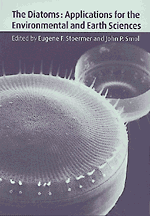Book contents
- Frontmatter
- Contents
- Contributors
- Preface
- Part I Introduction
- Part II Diatoms as indicators of environmental change in flowing waters and lakes
- Part III Diatoms as indicators in extreme environments
- Part IV Diatoms as indicators in marine and estuarine environments
- 13 Diatoms as indicators of coastal paleoenvironments and relative sea-level change
- 14 Diatoms and environmental change in brackish waters
- 15 Applied diatom studies in estuaries and shallow coastal environments
- 16 Estuarine paleoenvironmental reconstructions using diatoms
- 17 Diatoms and marine paleoceanography
- Part V Other applications
- Part VI Conclusions
- Glossary, and acronyms
- Index
14 - Diatoms and environmental change in brackish waters
Published online by Cambridge University Press: 16 January 2010
- Frontmatter
- Contents
- Contributors
- Preface
- Part I Introduction
- Part II Diatoms as indicators of environmental change in flowing waters and lakes
- Part III Diatoms as indicators in extreme environments
- Part IV Diatoms as indicators in marine and estuarine environments
- 13 Diatoms as indicators of coastal paleoenvironments and relative sea-level change
- 14 Diatoms and environmental change in brackish waters
- 15 Applied diatom studies in estuaries and shallow coastal environments
- 16 Estuarine paleoenvironmental reconstructions using diatoms
- 17 Diatoms and marine paleoceanography
- Part V Other applications
- Part VI Conclusions
- Glossary, and acronyms
- Index
Summary
Introduction
Brackish waters comprise a range of exclusive habitats which can be subdivided into three major categories: transition zones between freshwater and marine habitats, transition zones between hyperhaline water and marine habitats, and inland waters (no marine water exchange, see Fritz et al. (this volume) with higher salinity than freshwater. The salinities of these habitats vary from relatively stable (e.g., large saline lakes) to extremely unstable in time and space (e.g., estuaries bordering tidal seas). The main salinity regulating factors are inflow of freshwater, inflow of marine water, precipitation, evaporation and ice cover. In the past many efforts have been made to classify brackish waters according to salinity and the occurrence of biological species (Segerstråle, 1959; Anonymous, 1959; den Hartog, 1964). The more detailed such classifications are, the less well they fit all brackish waters. Based on the total concentration of ionic components (‰ Salinity) generally accepted approximate limits are: limnetic (freshwater) >0.5‰, oligohaline 0.5–5‰, mesohaline 5–18‰, polyhaline 18–30‰, euhaline 30–40‰, hyperhaline >40‰ (the ‘Venice System’: Anonymous, 1959).
There is little universality in responses of organisms to the peculiar conditions prevailing in numerous and generally widely separated brackish water bodies. Three factors must always be taken into account when using organisms as environmental markers for salinity: (i) In environments with fluctuating salinity regimes, the species are selected more according to their ability to cope with changing salinity (euryhalinity) than to their salinity optima.
- Type
- Chapter
- Information
- The DiatomsApplications for the Environmental and Earth Sciences, pp. 298 - 333Publisher: Cambridge University PressPrint publication year: 1999
- 23
- Cited by



